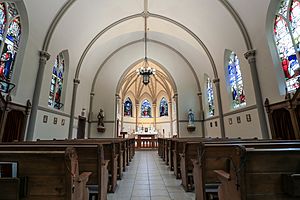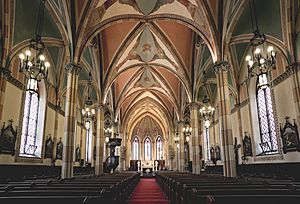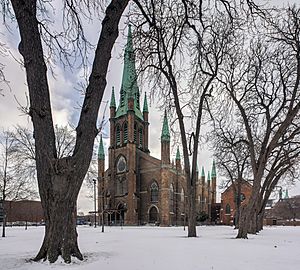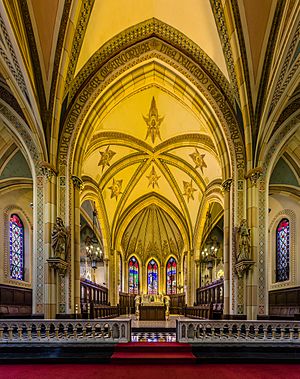Our Lady of the Assumption (Windsor, Ontario) facts for kids
Quick facts for kids Our Lady of the Assumption Windsor, Ontario |
|
|---|---|
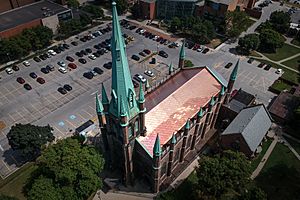
Assumption Church new roof, August 2019
|
|
| Denomination | Roman Catholic |
| Website | https://assumptionparish.ca/ |
| History | |
| Dedication | Our Lady of the Assumption |
| Administration | |
| Parish | Ontario |
| Diocese | Roman Catholic Diocese of London, Ontario |
| Province | Canada |
Our Lady of the Assumption is a historic Roman Catholic church in Windsor, Ontario. You can find it at 350 Huron Church Road. This church is special because it's the oldest continuous church community, called a parish, in Canada west of Montreal.
The church building you see today opened in 1845. It was actually the fourth church built on this very spot. In 2014, the building had to close. It needed about C$15 million worth of repairs to fix it up.
People worked hard to raise money for the church. Construction started in early 2019. This first part of the repair plan included a new copper roof. Workers also put in a new heating system and fixed the electricity. They made important repairs to the building's structure too.
The church was able to reopen for regular weekend services on September 8, 2019. The church community started the second part of the restoration plan in 2020. This phase focused on restoring the church's ceiling.
Contents
A Look Back: Church History
The church's story began in 1728. It was first known as "The Mission of Our Lady of the Assumption among the Hurons in Detroit." A Jesuit missionary, Father Armand De La Richardie, started it.
In 1765, a church measuring about 60 by 30 feet was built. It served the Huron people and about sixty French families. Assumption became an official church community in 1767. Its first leader was Father Pierre Potier. He stayed there until he passed away in 1781.
Building a New Church and School
After Father Potier, the bishop of Quebec sent Father Francois-Xavier Hubert. He was the bishop's special representative. Father Hubert planned to build a house for the priest, called a rectory, and a school. The Huron people helped by donating land for this project in 1782.
The rectory was built in 1785. In 1786, Father Hubert, who had moved to a new role, helped build a new church. He also sent two women from Quebec to start a school.
The new church opened in 1787. Father François-Xavier Dufaux became the new leader. Later, in 1796, Father Jean-Baptiste Marchand began his thirty-year time as the church's leader. When he passed away in 1825, his helper, Father Joseph Crevier, took over.
Laying the Cornerstone
On July 7, 1842, the first stone of the current church was laid. This is called the cornerstone. Three years later, on July 20, 1845, the new church was officially opened. It was a rectangular building, about 60 by 120 feet. This part of the building is now the main hall, or nave, of the church.
In 1857, Assumption College opened nearby. Two years later, in 1859, the bishop of the London Diocese moved his main office to Sandwich. He made Assumption church his main church, or cathedral.
On November 10, 1867, a new bishop, John Walsh, took over. In 1869, he moved the main office back to London. Father Pierre Dominic Laurent then took care of Assumption church.
Basilian Fathers and New Additions
In 1870, the Basilian Fathers from Toronto took charge of Assumption church and college. Their first leader was Father Dennis O’Connor. Four years later, in 1874, Father O’Connor oversaw the addition of the church's tower and the special area around the altar, called the sanctuary.
In 1893, Father François-Xavier Semande became the church leader. He had studied at Assumption College. He installed a new bell in the tower. In 1896, a new brick rectory was built. By 1902, both the rectory and the church had electricity.
In 1907, Father Alfred J. Côté became the leader. During his time, the rosary chapel and the sacristy (a room where priests prepare for services) were finished. These had been started by Father Semande.
The 20th Century and Beyond
From 1921 to 1926, Father Edmund Toussaint Burns was the leader. He made the side altars bigger and added the communion rail you see today. Father Edward William Allor followed him from 1926 to 1937. He started the Sunday Bulletin, a newsletter for the church.
Father James Alexander Donlon was the leader from 1944 to 1962. During his time, a statue of Our Lady of the Assumption was placed in the front yard. Several other priests led the church in the years that followed. Father Clifford J. Crowley oversaw the building of a new rectory.
In 1975, Father Lawrence J. Carney became the leader. During his time, the City of Windsor officially named Assumption church a historical building.
Recent Years and Restoration Efforts
Many different priests have led Assumption church in recent years. Under Father Daniel Zorzi, the Rosary Chapel was completely redone.
In 2007, Assumption Church began offering a special type of service called the Tridentine Latin Mass. This service is held on Sundays. The church's high altar, sanctuary, and pipe organ are perfect for this traditional service. It attracts people from all over southern Ontario and Michigan.
Around 2007, it became clear that Assumption church needed a lot of repairs. The cost was estimated at C$9.8 million. By 2012, the estimated cost had risen to about C$15 million.
The church building closed in November 2014 because its condition had gotten worse. Services continued in the smaller Rosary Chapel and at another church nearby. The Roman Catholic Diocese of London promised to help restore the church if enough money was raised.
In 2017, the church community celebrated its 250th year with many events. In early 2019, a local lawyer named Paul Mullins led a fundraising effort. He also helped create a four-part plan to restore the church building.
Construction on the first part of the plan began in the spring of 2019. This work included putting on a new copper roof that will last a long time. They also installed a new heating system, did major electrical work, and fixed parts of the building's structure.
The church community moved back into the main church building on September 8, 2019. They started celebrating weekend services there again. The church began the second part of the restoration plan in 2020. This phase focused on restoring the church's ceiling.


